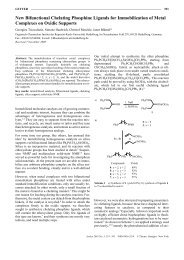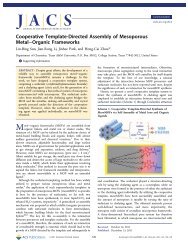Singlet Fission - Department of Chemistry
Singlet Fission - Department of Chemistry
Singlet Fission - Department of Chemistry
Create successful ePaper yourself
Turn your PDF publications into a flip-book with our unique Google optimized e-Paper software.
AP Chemical Reviews, XXXX, Vol. xxx, No. xx Smith and Michl<br />
first direct evidence for a two-step version <strong>of</strong> the mediated<br />
singlet fission mechanism (section 2.2.2).<br />
Methane bis[4′,4′′-(1,3-diphenylisobenz<strong>of</strong>uran)] (30), bis[4′,4′′-<br />
(1-(2′,6′-dimethylphenyl))-3-phenylisobenz<strong>of</strong>uran] (31), and<br />
bis(p,p′-1,3-diphenylisobenz<strong>of</strong>uran) (32) are <strong>of</strong> the linearly<br />
linked as opposed to the stacked type, and arguments <strong>of</strong><br />
section 2.2.2 again suggest that if singlet fission occurs at<br />
all, the mediated mechanism rather than the direct mechanism<br />
would be responsible. This would certainly be expected in<br />
the weakly coupled dimers 30 and 31, although perhaps not<br />
in the directly conjugated dimer 32, with its large overlap<br />
between the directly connected atoms <strong>of</strong> the link. Because<br />
in the case <strong>of</strong> 32 the two monomers are in direct conjugation,<br />
it is questionable whether the analysis <strong>of</strong> section 2.2.2 can<br />
be applied at all. Whereas the absorption and fluorescence<br />
spectra <strong>of</strong> 30 and 31 are very similar to those <strong>of</strong> monomeric<br />
8, the first transition <strong>of</strong> 32 is red-shifted by 2200 cm -1 . 82,86<br />
Thus, the dimer 32 may well be past the borderline <strong>of</strong> what<br />
can still be considered a pair <strong>of</strong> chromophores as opposed<br />
to a single conjugated π system. However, it has the<br />
flexibility to twist around the central bond after excitation,<br />
permitting an effective uncoupling <strong>of</strong> the two units <strong>of</strong> 8. In<br />
this regard, it is reminiscent <strong>of</strong> the carotenoids discussed in<br />
section 4.1.<br />
In nonpolar solvents, the dimers 30 and 31 exhibit only<br />
fluorescence and no detectable triplet formation, presumably<br />
because the rates provided for singlet fission by both the<br />
direct and the mediated mechanisms are too slow. In strongly<br />
polar solvents, triplet formation occurs with temperaturedependent<br />
yields ranging up to ∼9% (for 31 in DMF at 230<br />
K), and the triplet formation action spectrum follows the<br />
ground-state absorption spectrum. The triplet is not formed<br />
directly from the initially excited singlet state but from a<br />
nonemissive charge-transfer intermediate that consists <strong>of</strong> a<br />
radical cation <strong>of</strong> one <strong>of</strong> the chromophores linked to the<br />
radical anion <strong>of</strong> the other chromophore, and whose absorption<br />
spectrum is a superposition <strong>of</strong> the known 81 spectra <strong>of</strong> these<br />
radical ions. This dipolar intermediate is in rapid equilibrium<br />
with the initially excited singlet state, and in a slower<br />
equilibrium with a species whose absorption spectrum is<br />
indistinguishable from that <strong>of</strong> the triplet <strong>of</strong> 8. This cannot<br />
be the lowest triplet state <strong>of</strong> the dimer, which would be much<br />
lower in energy and could not return to the dipolar<br />
intermediate, and is assigned as a double-triplet state, in<br />
which both chromophores are excited. It is not known<br />
whether the two triplets are independent or coherently<br />
coupled into a quintet state <strong>of</strong> the dimer. The dependence<br />
<strong>of</strong> singlet fission in 30 and 31 on solvent polarity and the<br />
observation <strong>of</strong> a charge-transfer intermediate suggest that the<br />
mediated mechanism <strong>of</strong> section 2.2.2 is in operation, with<br />
the charge-transfer state occurring as a real rather than a<br />
virtual intermediate, making singlet fission a two-step process<br />
in this case.<br />
For dimer 32, the action spectrum <strong>of</strong> triplet formation is<br />
shifted by ∼1/4 eV to the blue relative to the absorption<br />
spectrum <strong>of</strong> the ground state. This is approximately the<br />
amount by which the S1 state excitation energy in this directly<br />
conjugated dimer is reduced relative to those in the monomer<br />
8 and in the weakly coupled dimers 30 and 31. It thus appears<br />
that the triplet is not stabilized by the conjugation and that<br />
in 32 singlet fission is endoergic by ∼1/4 eV and proceeds<br />
from vibrationally excited singlet states above a threshold<br />
energy, in competition with vibrational relaxation. This is<br />
an example <strong>of</strong> a linearly linked dimer in which stronger<br />
coupling appears to accelerate singlet fission but also<br />
disfavors it by making it endoergic, in agreement with<br />
calculations. 31<br />
In 32, singlet fission is observed in both polar and nonpolar<br />
solvents and the triplet yield varies from 1 to 3% in a manner<br />
that is not a simple function <strong>of</strong> solvent polarity. No<br />
intermediate is observed and the triplet forms directly from<br />
the initially excited singlet state. It is likely that in such a<br />
strongly coupled dimer the direct and the mediated mechanism<br />
cannot be disentangled, and further experimental and<br />
computational investigations are needed.<br />
7. Conclusions and Outlook<br />
7.1. Neat Materials<br />
For some time, the process <strong>of</strong> singlet fission has been well<br />
established and some aspects <strong>of</strong> it quite well understood in<br />
molecular crystals and, to a lesser degree, in neat polymers<br />
and oligomers. It appears to be fast and important in neat<br />
materials whenever singlet excitation is present at energies<br />
comparable with twice the energy <strong>of</strong> the lowest triplet<br />
excitation. This occurs in two sets <strong>of</strong> circumstances.<br />
(i) In ordinary materials, when E(S1) , 2E(T1) (materials<br />
<strong>of</strong> type I), singlet fission is rarely important, and needs<br />
consideration only rarely, when a highly excited singlet is<br />
produced. This situation results from events such as the<br />
absorption <strong>of</strong> high-energy photons, electron-hole recombination,<br />
or high-intensity irradiation that permits significant<br />
singlet exciton fusion even when low-energy photons are<br />
used.<br />
(ii) In the rare materials <strong>of</strong> type II, in which E(S1) ≈ 2E(T1)<br />
or E(S1) > 2E(T1), singlet fission occurs whenever singlet<br />
excitation is present and it is an integral part <strong>of</strong> their<br />
photophysics. At present, the polyacenes 2 and 3, the<br />
biradicaloid 8, some carotenoids (13-21), and polydiacetylenes<br />
(22) are the only thoroughly studied representatives<br />
<strong>of</strong> this class <strong>of</strong> materials, and the behavior <strong>of</strong> 3 is not<br />
understood.<br />
The triplet excitons produced by singlet fission in materials<br />
<strong>of</strong> type I are not formed in high yield under conditions<br />
relevant for photovoltaic applications since singlet fission<br />
has to compete with other fast processes that remove excess<br />
excitation energy. Moreover, they usually stand a good<br />
chance <strong>of</strong> re-fusion (annihilation) to yield S1 in an exoergic<br />
process. Even in those materials <strong>of</strong> type II that do not satisfy<br />
the condition E(T2) > 2E(T1) (type IIA), such as the<br />
carotenoids, triplet exciton re-fusion is likely to occur fast<br />
with the formation <strong>of</strong> vibrationally excited T1 and release<br />
<strong>of</strong> vibrational energy, and this has been observed in 21. If<br />
the multiplication <strong>of</strong> the number <strong>of</strong> excitons by the singlet<br />
fission process is to be made useful in a practical sense, for<br />
instance in a solar cell, it would be preferable to choose those<br />
materials <strong>of</strong> type II for which the condition E(T2) > 2E(T1)<br />
is satisfied (type IIB). Structural guidelines for a search for<br />
suitable chromophores30 are summarized in section 2.2.1, and<br />
considerations that provide some guidance with respect to<br />
the optimization <strong>of</strong> their mutual coupling are outlined in<br />
section 2.2.2. The presently least well understood part <strong>of</strong><br />
the quest for practical singlet fission materials is assuring<br />
two independent charge separation events (section 2.3). It is<br />
not yet clear whether nanocrystals or thin layers <strong>of</strong> these<br />
materials would be best for the purpose. In either event, one<br />
has little control over the solid-state structure and little<br />
opportunity to manipulate interchromophore coupling. One



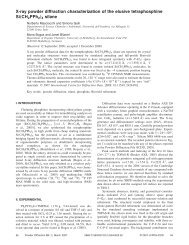
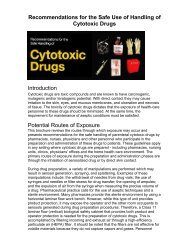
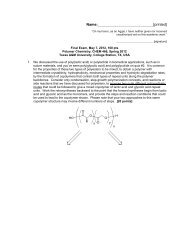

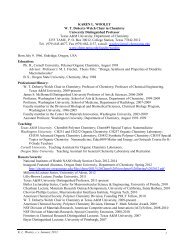
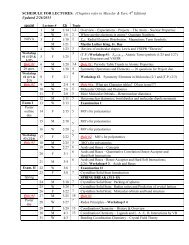
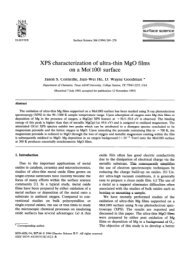
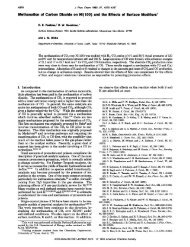
![Radical salts of TTF derivatives with the metal–metal bonded [Re2Cl8]](https://img.yumpu.com/10115211/1/190x253/radical-salts-of-ttf-derivatives-with-the-metal-metal-bonded-re2cl8.jpg?quality=85)



